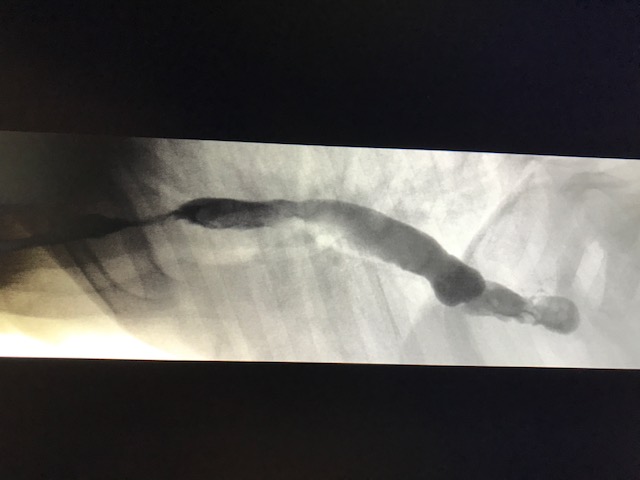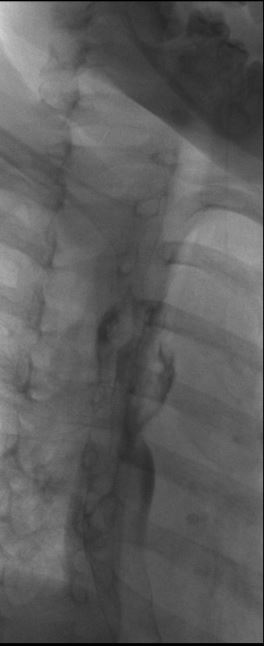GA4-82
Fatal gastrointestinal bleeding 1 day after ingestion of lithium battery in 2 year old
1Aboul-Fettouh A, 2Chandran N, 2Miller J, 2Gonzales C
1university of campbell school of osteopathic medicine, Hope mills, North caro, USA; 2UTSW, children's medical center, Dallas, Texas, USA
2 yo w/no pmhx transferred from OSH p/w with swallowing difficulty, abdominal pain & fever x1 day found to have presumed lithium battery in mid esophagus, Brought to OR for FB removal. Upon removal of battery, esophagoscope revealed presence of 75% circumferential esophageal injury 2 cm in length with mucosal sloughing & ulceration at mid esophagus. Post-op esophagram revealed abnormal esophagus extending from T3 to T5 with narrowing, irregularity and delayed peristalsis compatible with an anterior ulceration & contrast extending into left mediastinum c/w perforation. Patient admitted to the floor, remained NPO, started on antibiotics & TPN started through PICC line, Two days later, patient suddenly decompensated with severe bradycardia, desaturation & hypotension with blood from mouth, nose and rectum, CPR and MTP initiated, While coding, emergently taken to OR for left thoracotomy for presumed aorto-esophageal fistula, Lateral thoracotomy incision made, internal CPR performed by surgeon & unable to identify hole in empty flat aorta. Patient remained unresponsive despite resuscitative efforts and was pronounced dead in OR. No postmortem autopsy.
The ingestion of foreign bodies in children is very common, Batteries represent less than 2% of ingested FB and the mortality rate related to FB ingestion (1). Button batteries can cause tissue damage either by alkaline leakage or by release of electrical energy that burn surrounding tissue (2). 15% impaction occur in midesophagus. Only a few hours may be needed to cause major complications or even death. 13% of complications were due to tracheal injuries, 7% to tension pneumothorax and 80% secondary to fatal hemorrhage. X-ray is standard for diagnosis, Immediate removal of FB is recommended followed by an esophagram which in our case detected mediastinal leak of the contrast.
Management of esophageal disruption and contained perforation is conservative treatment which include ICU care, NPO, TPN, & antibiotics. Most cases with vascular injury are complicated by severe exsanguinating hemorrhage leading to cardiac arrest and death (3). Aortal-esophageal fistula is extremely uncommon. Despite intensive resuscitation and rapid transfer to OR, surgeon was unable to identify the fistula to stop the bleeding.
(1) Thabet MH et al, Button battery FB in children : hazards, management and recommendations Biomed Res. Int 2013: 84609
(2) Tanka J et al ,esophageal electrochemical burn due to button type batteries in dogs. Vet hum toxicology 1998,40:193-6
(3) Sara Fuentes et al, severe esophageal injuties caused by accedintal button battery ingestion. J Emerg Trauma Shock 2014 & 940 316-321
Top













